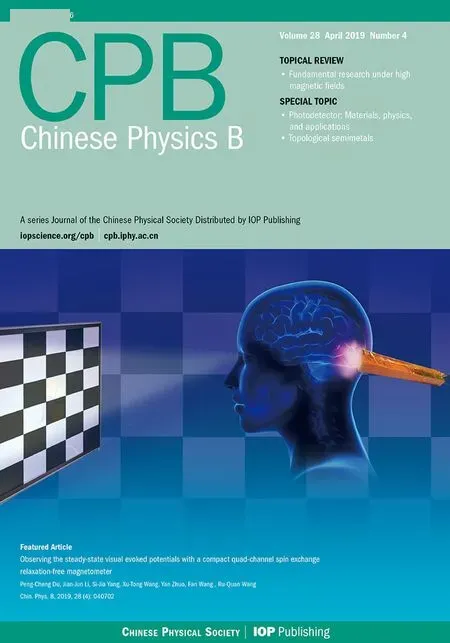Effect of terahertz pulse on gene expression in human eye cells∗
2019-04-13JinWuZhao赵晋武MingXiaHe何明霞LiJieDong东莉洁ShaoXianLi李绍限LiYuanLiu刘立媛ShaoChongBu步绍翀ChunMeiOuyang欧阳春梅PengFeiWang王鹏騛andLongLingSun孙珑玲
Jin-Wu Zhao(赵晋武),Ming-Xia He(何明霞),†,Li-Jie Dong(东莉洁),Shao-Xian Li(李绍限),Li-Yuan Liu(刘立媛),Shao-Chong Bu(步绍翀),Chun-Mei Ouyang(欧阳春梅),Peng-Fei Wang(王鹏騛),and Long-Ling Sun(孙珑玲)
1School of Precision Instrument and Opto-electronics Engineering,The Center for Terahertz Waves,Tianjin University,Tianjin 300072,China
2Eye Institute and School of Optometry and Ophthalmology,Tianjin Medical University Eye Hospital,Tianjin 300384,China
3Key Laboratory of Opto-electronics Information Technology and Technical Science,Ministry of Education,Tianjin University,Tianjin 300072,China
4State Key Laboratory of Precision Measuring Technology and Instruments,Tianjin University,Tianjin 300072,China
1.Introduction
Terahertz wave(THz wave),also named THz radiation,is a type of non-ionizing electromagnetic waves,resulting from its low photon energy with frequencies ranging from 0.1 THz to 10 THz(1 THz=1012Hz).Since the suitable generators and detectors were developed in the 1980s,[1,2]THz technology has exhibited great potential applications in many fields including medical and biological imaging,security screening,quality control of food and pharmaceuticals,ultrafast computing,and wireless communication.[3–5]Some applications,including body scanners employed at airports,and THz imaging used in diagnostics will result in exposure of the general public to THz radiation.Thus,there are many concerns about the biological effects of THz radiation on humans.
The peculiarity of THz wave lies in the fact that its photo energy corresponds to rotational modes and oscillations of collective modes of biomolecules,including deoxyribonucleic acid(DNA)and proteins.[6,7]It has been proposed that the THz radiation may couple to the vibration modes of biomolecules,and thus influence the biological system.A few studies have been performed to provide the effects of THz radiation on cell viability,growth,morphology and genotoxicity,[8–11]and thermal effects were observed to be dominant in the case of high power continuous wave.[12]In addition,more investigations on THz effects were conducted under strictly controlled thermal conditions to minimize the thermal effects.It was found that extended exposure of mouse mesenchymal stem cells(mMSCs)to broadband THz source centered at∼10 THz led to transcription changes of specific genes,by which THz radiation could accelerate stem cells differentiation toward adipose phenotype.[13,14]Similar effects were observed in a follow-on study of mMSCs,which reported that the effect of THz radiation on gene expression depended on exposure parameters,including irradiation duration,THz source type and the degree of stem cell differentiation.[15]In addition to mMSCs,experiments on artificial human skin tissues have also demonstrated that intense picosecond-duration THz pulses affected the expression levels of numerous genes associated with some skin diseases.[16]It has also been shown that the exposure to intense THz pulses may cause the DNA to be damaged,and the levels of several proteins responsible for cell-cycle regulation and tumor suppression to increase.[17]In agreement with these data are the changes in the gene expression of human embryonic stem cells,which have also been documented,after being exposed to 2.3-THz radiation.[18]However,it is difficult to draw a general conclusion of the mechanisms by which THz radiation interacts with biological tissue due to various exposure conditions.
In general,stem cells are susceptible to small changes in their environment,making it an appropriate means to investi-gate the response to THz stimulus.Due to the limited penetration of THz wave to human body,previous studies of THz effects have selected human skin tissue and fibroblasts as biological materials.In addition,human eyes can be directly exposed to THz radiation.The spectral characteristics of ocular tissue in terahertz band have been reported recently,including the cornea and the scler.[19,20]Thus,a detailed investigation of the effects in different eye cells could be of practical necessity and importance.
In this work,we study the long term effects of 6-hour THz radiation in the form of pulses on three different types of eye cells,namely:human retinal pigment epithelial cells,human corneal epithelial cells,and human Müller cells.The irradiation is performed at∼ 37◦C with an average power of∼1 mW,and ribonucleic acid(RNA)isolation of exposed cells and control cells is performed 15 hours after irradiation.By means of transcriptome sequencing(RNA-seq)and RNA-seq analysis tools,we observe THz pulses induced changes in the expression of specific genes in exposed versus control cells,lasting over 15 hours.In addition,differentially expressed genes related to cell type have been found to be involved in specific cellular processes and biological functions.
2.Materials and methods
2.1.THz pulse source set-up
A homebuilt terahertz time-domain spectroscopy system was used as a THz radiation source.The 800-nm pulses with a repetition rate of 1 kHz from Ti:sapphire amplifier are focused into an LiNbO3crystal in tilted-pulse-front geometry to achieve velocity matching[21,22]as shown in Fig.1.THz pulses are generated through optical rectification,and the generated THz pulse has a time duration of 0.5 ps and peak electric field up to 150 kV/cm at the focus of two parabolic mirrors.
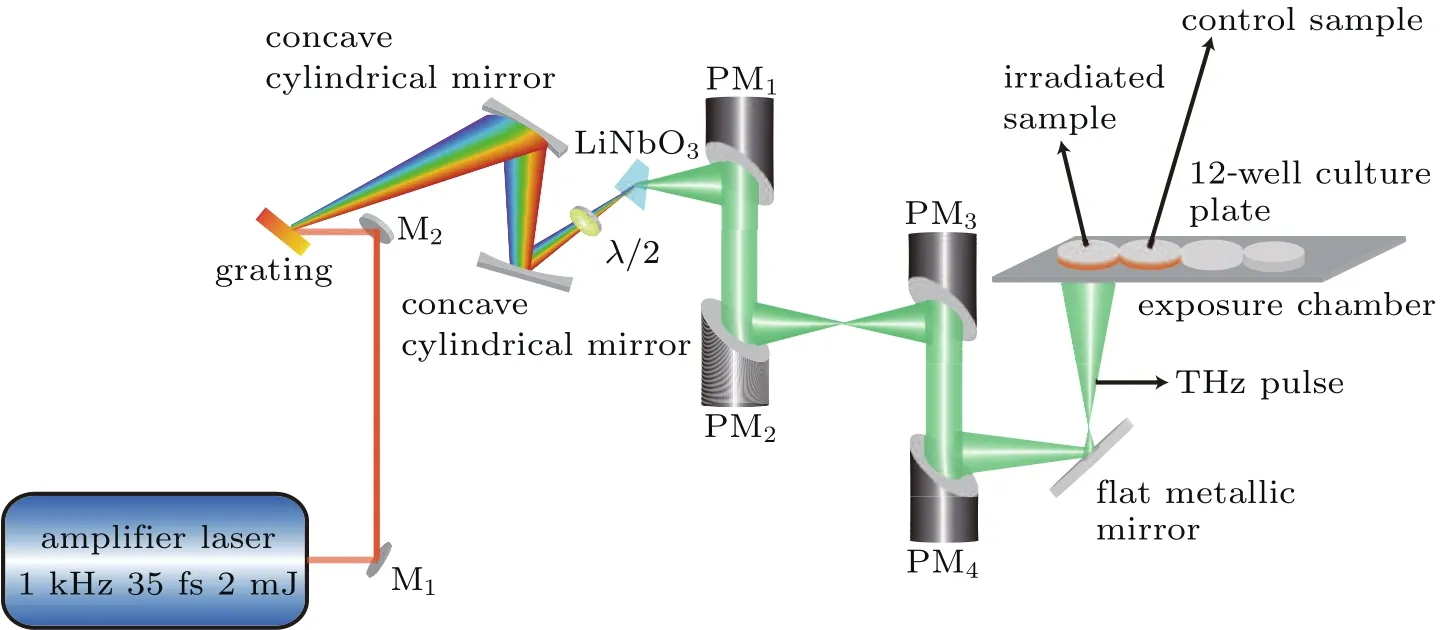
Fig.1.Schematic representation of experimental setup for exposure of cells to THz pulse radiation,displaying tilted-pulse-front THz pulse source.The THz beam is directed by flat metallic mirror to propagate to bottom surface of 12-well culture plate.M,PM,and λ/2 represent flat mirror,paraboloidal mirror,and half-wave plate,respectively.
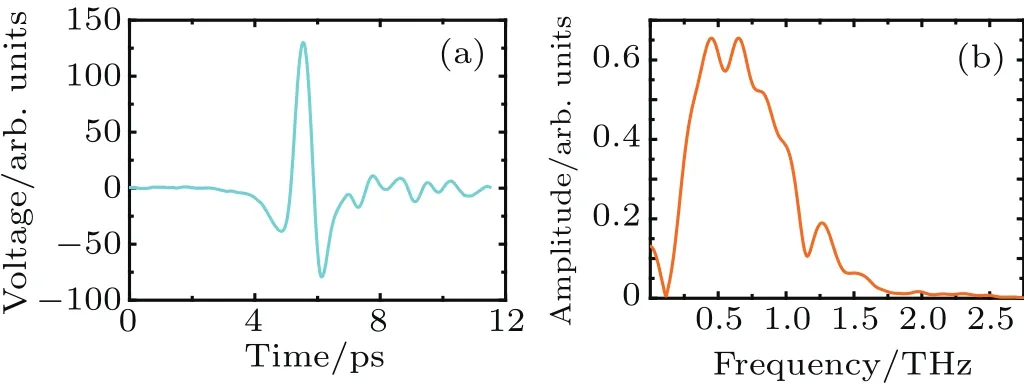
Fig.2.Waveform of(a)THz pulse intensity in time domain and(b)corresponding amplitude spectrum in frequency domain.
The THz wave intensity measured by electro–optic equivalent sampling in ZnTe crystal is shown in Fig.2.The corresponding frequency domain spectrum obtained by applying fast Fourier transform is peaked at 0.7 THz with a full width at half maximum(FWHM)of 0.9 THz.The single pulse energy measured by opto-acoustic detector(Golay cell,Tydex)was close to 1µJ.Thus,the average THz radiation power was evaluated to be approximately 1 mW,which yielded temperature increases less than 0.2◦C according to Pennes bio-heat transfer equation and the steady-state theoretical model.[23]The broadband THz source allows the investigation of THz effects due to the high peak power up to 2 MW,when the low average power is maintained to eliminate thermal effects.
2.2.Cell culture and exposure conditions
Three different types of eye cell lines were used(which were obtained from eye institute and school of optometry and ophthalmology,Tianjin medical university eye hospital),namely:human ARPE-19 retinal pigment epithelial cells(RPE for short),simian virus 40-transformed human corneal epithelial cells(HCE for short),[24]and human MIOM1 Müller cells(Müller for short).The cells were cultured in DMEM/F12 medium(Basalmedia,China)supplemented with 10%foetal bovine serum(FBS,Bovogen,Australia)and 1%penicillin/streptomycin solution(Gibco,USA)on culture dishes(NEST Biotechnology,China).Then,the cells were maintained in cell incubator(Thermo,USA)under standard conditions of 5%CO2and humidified atmosphere at 37◦C,while regularly changing the media and subculturing them onto fresh dishes when they are confluent by using trypsin(Gibco,USA).
The cells were seeded into 12-well cell culture plates 24 hours before THz exposure(NEST Biotechnology,China),with 1 ml of medium at a density of 1×105cells.For the control group,cells with the same passage were seeded adjacent to the exposed cells.To ensure that the cells were maintained in environments suitable for their long term survival,we used a custom-designed exposure chamber to keep the temperature at 36◦C–37◦C.The exposure chamber was made of insulating material,in which a circulator water bath device was used to control the temperature,assisted with an electronic thermometer(0.1◦C resolution)to measure the air temperature within the exposure chamber.A flat metallic mirror was used to direct THz radiation into the exposure chamber from below.The THz beam naturally diverged to a beam diameter that had approximately the size of the culture well and the corresponding average power density is nearly 0.3 mW·cm−2.Since the culture plate made of polystyrene has the low absorption of THz radiation,[10]and the cells formed a monolayer adherent to the bottom,THz radiation could penetrate cells before being incident into the culture medium.
Cells with fresh culture medium were exposed to pulsed THz radiation for 6 hours,followed by incubation at 37◦C in 5%CO2atmosphere for 15 h without changing medium.Based on the calculation of gas flow rate,CO2was introduced into the exposure chamber with a duration of 12 s before THz irradiation,and the color of the medium did not change obviously due to the change of pH value.Owing to the large sample volumes required for RNA-seq,yields of four independent irradiation experimental replicates were pooled for postprocessing.
2.3.Transcriptome sequencing
The RNA-seq data are derived from sequencing of transcriptome and an alignment of the sequence to a reference genome,which yields highly reproducible results comparable to those of gene expression microarray.[25]Total RNA was individually harvested from the irradiated cell cultures of three different cell types and their respective controls,using TRI-zol reagent(Invitrogen,USA)according to the instructions of manufacturer.After assessing the purity,quantity and integrity of RNA samples,appropriate samples with an RNA integrity number(RIN)greater than 9.0 were subjected to library preparation.Messenger RNA(mRNA)was purified from total RNA with a value of 3µg as the input.Sequencing libraries were generated by using NEBNext UltraTM RNA Library Prep Kit for Illumina(NEB,USA)following the recommendations.After cluster generation by using TruSeq PE Cluster Kit v3-cBot-HS(Illumia),the library preparations were sequenced on an Illumina Hiseq platform and 125 bp/150 bp paired-end reads were generated.
The raw data were purified to obtain clean data by removing low quality reads.The mapping of clean reads to the reference genome was performed by using STAR(v2.5.1b)based on the method of Maximal Mappable Prefix(MMP).[26]The results of complete sequence alignment conditions as shown in Table 1,indicated that the uniquely mapping rates of all samples were greater than 93%.The fragments per kilobase million(FPKM)was subsequently calculated for estimating gene expression,based on the length of the gene and the reads count of clean data acquired by HTSeq v0.6.0 software.

Table 1.Complete sequence alignment conditions of samples.
3.Results
3.1.Long term effects
To investigate the long term influence of pulsed THz exposure on gene expression profile of cells,the analysis of differential gene expression is performed by using the edgeR R package(3.12.1)based on negative binomial distribution test.[27]Benjamini and Hochberg false discovery rate(FDR)is used to eliminate the false positives,although it is unable to find all differentially expressed genes.[15,28]Employing common significance criteria of FDR-adjusted statistical significance(p-values)≤0.05,and expression fold change of twofold down-or up-regulation at least,differentially expressed genes(DEGs)in three cell types are listed in Table 2.
For RPE cells,this analysis yields a total of 6 DEGs in the control versus exposed culture.In detail,the expression of RET,ALK,ROS1,FGFR2,and COL1A2 genes are upregulated after THz irradiation,among which the largest fold change is recorded for RET.The RET,ALK,and ROS1 belong to the family of tyrosine kinase receptor,which play a role in cell growth,differentiation and migration.[29,30]In addition,FGFR2 is a member of the fibroblast growth factor re-ceptor family.[31]Taken together,the observed up-regulations of these four genes may be suggestive of a higher level of sensitivity to the activation of a series of cellular processes.Indeed,it was previously shown that receptor tyrosine kinases are related to the development and progression of many types of cancers,while further investigations are needed to explore whether THz radiation can induce the RPE cells to transform into cancer cells.
Furthermore,there is only one statistically significant gene differentially expressed in HCE cells,named CENPE,which is down-regulated responded to the THz exposure.The CENPE is a kinesin-like motor protein,which is required for stable spindle microtubule capture at kinetochores during prometaphase of the cell cycle.The down-regulation of CENPE gene expression may be related to aneugenic effects observed in human fibroblasts exposed to THz radiation in some researches.[10,32]While,in contrast to HCE cells,no gene in this significant criterion is affected by the THz exposure in Müller cells.In brief,the observations suggest that the influence of THz pulse on specific gene expression could last over 15 hours.

Table 2.Differentially expressed genes.The list of genes identified by the RNA-seq when possessing differential expression with statistical significance(FDR-adjusted p-value≤0.05)of different cell types.
3.2.Cell type dependence
We examine the genes with less statistically significant evidence for their differential expression(p-value≤0.05,not adjusted for multiple testing corrections,expression fold change≥1.5),which may provide more information about biological effects of THz radiation on a larger scale.To clearly visualize the global distribution of the DEGs out of over 23000 genes,volcano plots are presented in Fig.3.

Fig.3.Volcano plots of gene expression profiles in(a)RPE,(b)HCE,and(c)Müller cells.Fold change of expression magnitude is plotted versus level of statistical significance(transformed into a logarithmic scale).Note that red,green and gray color represent genes whose expression is considered up-regulated,down-regulated and unchanged,respectively.Besides,triangles represent the DEGs with FDR-adjusted pvalue≤0.05.Complete lists of DEGs,and corresponding fold change of expression and p-value are given in Data File 1.
Figure 3 shows a total of 297 DEGs detected with the cut-off criteria,141 of which were up-regulated,156 downregulated in the control versus exposed cultures of RPE cells.For HCE cells,exposure to THz pulses changes the expression of 242 genes.The irradiation also affects the expression of 227 genes as compared with the control group in Müller cells.Overall,we find that THz radiation changes the transcription of approximately 1%of genes analyzed,which suggests that THz pulse may not have a strong or global influence on gene expression and its influence is only limited to a few genes.Meanwhile,none of the heat shock protein encoding genes are significantly up-regulated in exposed cells,which is in accordance with the scenario of the estimated temperature increasing as a result of THz exposure,demonstrating a minimum effect on gene expression caused by the THz-induced heating.
According to these data,now we come to analyze the overlaps in the plots of genes differentially expressed in three cell types.It is found that these genes are strongly different from each other in each of the cell types as shown in a Venn diagram(Fig.4).While there is a little overlap between genes in every two of three cell types,no overlap exists among the gene expression profiles of all three cell types.We identify 18 DEGs that are common for two of three cell types,of which five genes are up-regulated and three genes are downregulated due to the THz exposure.While,the other 10 genes display an opposite regulation when irradiated in different cell types.These considerable differences in gene expression profiles suggest that the influence of THz pulse is dependent on the type of cell.In addition,it may provide a hint toward the direct targets for the THz effects,which could exhibit the specificities of different cell types.
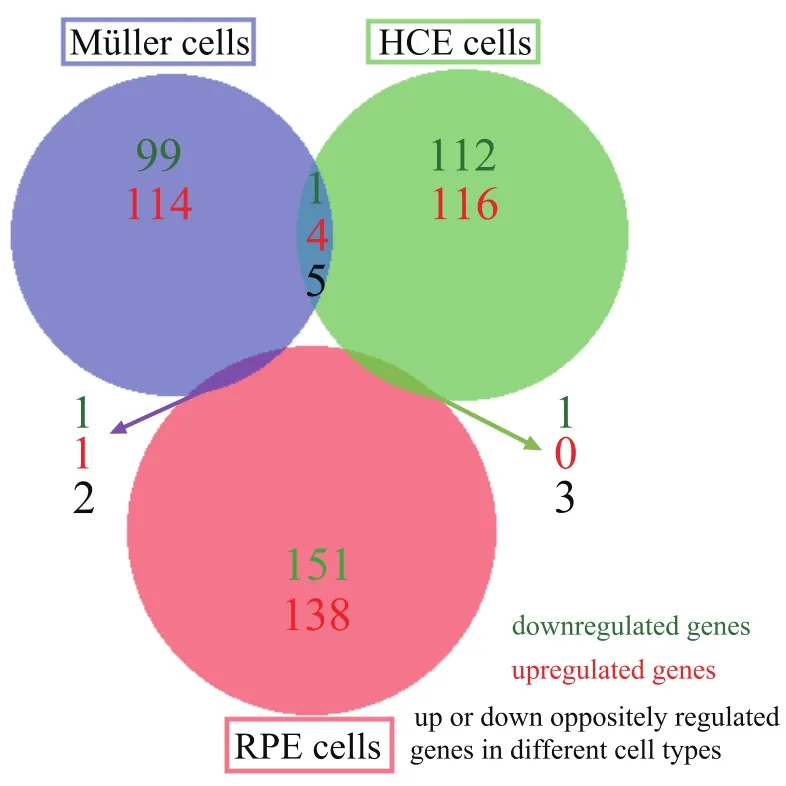
Fig.4. Venn diagram indicating down-regulated(green)and upregulated(red)genes with p-value≤0.05(not adjusted for multiple testing corrections)in these three cell types.Black color represents differentially expressed genes displaying opposite regulation in different cell types.
3.3.Biological functions and alternative splicing affected by THz radiation
For further investigation on the specific biological functions affected by the THz radiation,the cluster Profiler R package(3.4.0)is used for gene ontology analysis based on Fisher’s exact test.Gene ontology(GO)represents an internationally standardized system for gene functional classification,covering three domains,i.e.,cellular component,molecular function,and biological process.The functional classification of the DEGs with p-value≤0.05 reveals clear differences among the three cell types.Data in Fig.5 are presented as the four GO terms with the highest level of statistical significance for each of the cell types.
Using the significance cutoff at the threshold value(FDR-adjusted p-value≤0.05),53 functional GO terms are significantly enriched for the DEGs of RPE cells,among which five functional classes for molecular function are mainly related to the receptor protein kinase activity and motor activity, five GO terms belonging to cellular component domain are mainly in connection with extracellular matrix,and others about biological process are mainly linked to biological system development,differentiation and metabolic process.As for HCE cells,the GO analysis reveals statistically significant enrichment of DEGs in 14 GO terms concerning molecular function,which are mainly relevant to transmembrane transporter activity and ion channel activity.Only two enriched functional GO classes associated with biological process are identified for Müller cells,which are involved in metabolic process.The complete lists of GO terms significantly enriched with FDR-adjusted p-value≤0.05 in three cell types are given in Data File 2.
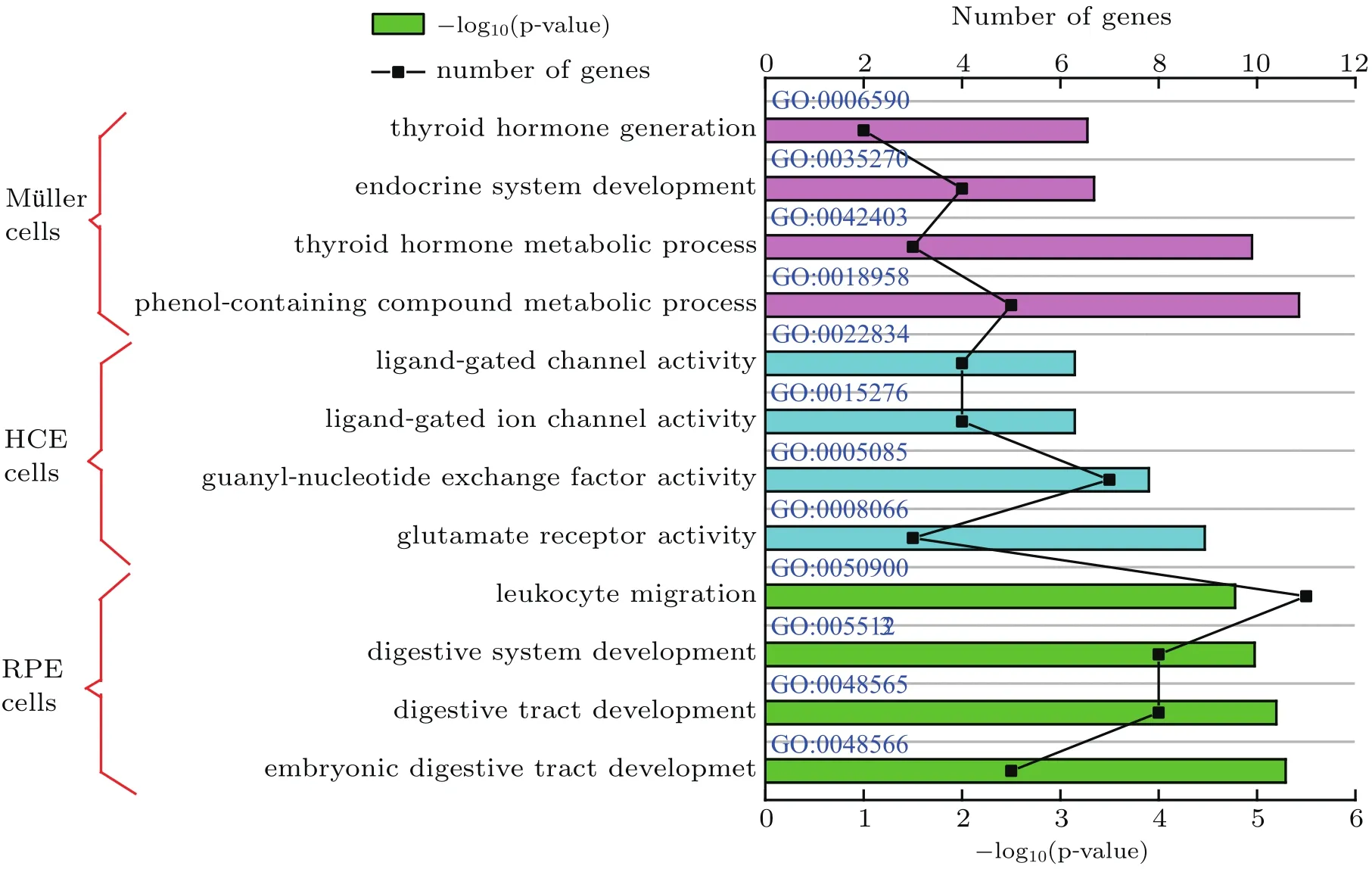
Fig.5.Gene ontology enrichment analysis of differentially expressed genes. The first 4 GO terms with the highest level of statistical significance for three cell types are presented.Line graphs indicate the number of differentially expressed genes in specific GO terms,while bar graphs represent the level of statistical significance for enrichment.Complete lists of GO terms significantly enriched with FDR-adjusted p-value≤0.05 in three cell types are given in Data File 2.
Alternative splicing(AS)is an important mechanism for regulating the expression of genes and the variable of protein,which results in a single gene coding for multiple proteins.The process of AS is regulated by a system of trans-acting proteins that bind to cis-acting sites on the primary transcript.[33]To determine the AS events that are affected in response to THz pulses,rMATS(3.2.1)software is used to analyze the AS events based on likelihood-ratio test.The data shown in Fig.6 illustrate the number of AS events influenced by THz radiation applying the common significant criteria(FDR adjusted p-value≤0.05).In RPE,HCE,and Müller cells, five,two,and six affected AS events are obtained,respectively,which are not uniformly distributed among the five types of AS events,but mainly concentrated in one or two types.The proportion of affected AS events is not more than 0.01%,which indicates that the effect of terahertz radiation on the AS event is specific.The complete lists of AS events significantly affected by FDR adjusted p-value≤0.05 in three cell types are given in Data File 3.
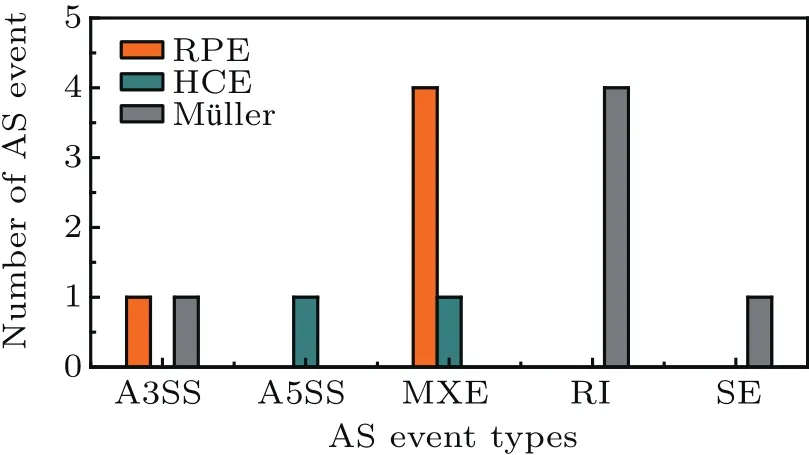
Fig.6.AS events analysis,showing the number of AS events influenced by THz radiation applying the common significant criteria(FDR adjusted p-value≤0.05)in three cell types.A3SS,A5SS,MXE,RI,and SE represent five types of AS events,alternative 3’splice site(acceptor site),alternative 5’splice site(donor site),mutually exclusive exons,retained intron and skipped exon,respectively.The complete lists of AS events affected by THz radiation with FDR adjusted p-value≤0.05 in three cell types are given in Data File 3.
4.Discussion and conclusions
In our experiments,RPE,HCE,and Müller are exposed to THz pulses for 6 hours in a custom-designed exposure chamber.Following culture in cell incubator for 15 hours,the RNA isolation of exposed cells and control cells are performed.Obvious cellular gene expression differences are recorded between all three types of irradiated cells and those of their control cells. Owing to the low average power of THz pulse source used in our study,the temperature increase of only 0.2◦C at most is biologically insignificant.In addition,on account of the ultrashort duration of THz pulse on a scale of picosecond,it is assumed that the energy transfer to biological tissues is completed in adiabatic condition,with little thermal accumulation.Thus,the effects on gene expression would not result from heating caused by the strong absorption of water in biological materials at THz frequencies.
In a biological system,there exist several natural mechanisms for regulating gene expression,among which the DNA methylation is one of the common ways of gene modification.DNA methylation is a process that may affect the transcription of genes through its occupying the protein binding sites and changing chromatin structure.[34]Meanwhile,the energy scale of THz wave is within the range of hydrogen bonds and van der Waals forces,which determine the higher-order structures of biomolecules.Thus,through interacting with the secondary bonds of biomolecules,the THz radiation may influence the dynamics of molecular spatial structure change,and furthermore the molecular recognition and binding process in the transcription of genes,which is similar to the mechanism of DNA methylation.Based on research on direct the effects of THz radiation on double-stranded DNA hybridization and enzymatic process,[35,36]the processes affected by the THz radiation mainly include the DNA unwinding,the binding of protein factor and enzyme to DNA and precursor messenger RNA.
In 1968,Frölich proposed that non-thermal effect of THz radiation may be caused by coherent excitation.[37]Combining with a mathematical model of DNA breathing mode,it has been proposed that THz radiation may couple to the breathing mode of DNA,thereby creating new open states in the double helix through nonlinear resonance mechanism.[15,38]Meanwhile,due to the lack of direct experimental result to prove these hypotheses,the comprehensive models that are currently used to explain how such THz biological effects may arise are still under debate.Recently,the number of genes affected under single frequency THz radiation was found to be much lower than that under broadband THz radiation.[15]This provides a hint that further efforts should be focused on the analysis of genes affected by different single or narrow frequency within the spectrum of broadband THz radiation to determine the relationship between genes and THz frequency.It is important to note that the energy of THz pulse can directly influence part of genes.[16]Thus,it is necessary to keep the energy constant while changing the frequency of THz pulse,or select genes unaffected by the energy as the target.Furthermore,the experiments on the changes of molecular process in the transcription of selected gene pumped by the corresponding frequency of THz wave show that our hypotheses on the mechanism of terahertz effects on gene expression can be validated.Therefore,the methods and results in this paper provide the foundation of the next study.
In summary,we have shown that THz pulse have effects on gene expression profiles in three types of cells.Using the FDR method for multiple testing corrections,expression changes of seven genes are observed after THz exposure.This suggests that the influence on gene expression can last over 15 hours,which is supported with strong statistical ev-idence.Furthermore,with p-value≤0.05 without FDR correction used as a significant criterion,it is interesting to note that no overlap exists among the DEGs of all three cell types,which demonstrates that the THz influence is dependent on the type of cells.Although the three cell types used in our experiment are derived from the same organ,considering their responsible different functions in eye,it should be no surprise that the change of gene expression is strongly different in each of the cell types.Our study provides a valuable picture of the genes,cellular process and AS events that are specifically affected in different cell types exposed to THz pulse.Thus,further investigations into THz induced effects on gene expression under various exposure conditions are necessary to investigate the mechanism of THz effects,including the intensity and frequency range of THz radiation,exposure duration,time points for detection,especially the exposure of normal cells and cell models with specific gene silencing.
Acknowledgment
We are grateful for the instruments and methods for cell culture to the eye institute and school of optometry and ophthalmology at Tianjin Medical University Eye Hospital.
[1]Ferguson B and Zhang X 2002 Nat.Mater.1 26
[2]Lewis R A 2014 J.Phys.D:Appl.Phys.47 374001
[3]Wilmink G J and Grundt J E 2011 J.Infrared Millim.Terahertz Waves 32 1074
[4]Wang Y,Ren Y,Chen L,Song C,Li C,Zhang C,Xu D and Yao J 2018 Chin.Phys.B 27 114204
[5]Liu C,Wang C,Cao J 2016 Chin.Phys.B 25 028702
[6]Whitmire S E,Wolpert D,Markelz A G,Hillebrecht J R,Galan J and Birge R R 2003 Biophys.J.85 1269
[7]Fischer B M,Walther M and Uhd Jepsen P 2002 Phys.Med.Biol.47 3807
[8]Clothier R H and Bourne N 2003 J.Biol.Phys.29 179
[9]Hintzsche H,Jastrow C,Heinen B,Baaske K,Kleine-Ostmann T,Schwerdtfeger M,Shakfa M K,K¨arst U,Koch M,Schrader T and Stopper H 2013 Radiat.Res.179 38
[10]Amicis A D,Sanctis S D,Cristofaro S D,Franchini V,Lista F,Regalbuto E,Giovenale E,Gallerano G P,Nenzi P,Bei R,Fantini M,Benvenuto M,Masuelli L,Coluzzi E,Cicia C and Sgura A 2015 Mutat.Res.Genet.Toxicol.Environ.Mutagen.793 150
[11]Borovkova M,Serebriakova M,Fedorov V,Sedykh E,Vaks V,Lichutin A,Salnikova A and Khodzitsky M 2017 Biomed.Opt.Express 8 273
[12]Wilmink G J,Rivest B D,Roth C C,Ibey B L,Payne J A,Cundin L X,Grundt J E,Peralta X,Mixon D G and Roach W P 2011 Lasers Surg.Med.43 152
[13]Bock J,Fukuyo Y,Kang S,Phipps M L,Alexandrov L B,Rasmussen K Ø Bishop A R,Rosen E D,Martinez J S,Chen H,Rodriguez G,Alexandrov B S and Usheva A 2010 Plos One 5 e15806
[14]Alexandrov B S,Rasmussen K Ø Bishop A R,Usheva A,Alexandrov L B,Chong S,Dagon Y,Booshehri L G,Mielke C H,Phipps M L,Martinez J S,Chen H and Rodriguez G 2011 Biomed.Opt.Express 2 2679
[15]Alexandrov B S,Phipps M L,Alexandrov L B,Booshehri L G,Erat A,Zabolotny J,Mielke C H,Chen H,Rodriguez G,Rasmussen K Ø Martinez J S,Bishop A R and Usheva A 2013 Sci.Rep.3 1184
[16]Titova L V,Ayesheshim A K,Golubov A,Rodriguez-Juarez R,Woycicki R,Hegmann F A and Kovalchuk O 2013 Sci.Rep.3 2363
[17]Titova L V,Ayesheshim A K,Golubov A,Fogen D,Rodriguez-Juarez R,Hegmann F A and Kovalchuk O 2013 Biomed.Opt.Express 4 559
[18]Bogomazova A N,Vassina E M,Goryachkovskaya T N,Popik V M,Sokolov A S,Kolchanov N A,Lagarkova M A,Kiselev S L and Peltek S E 2015 Sci.Rep.5 7749
[19]Iomdina E N,Goltsman G N,Seliverstov S V,Sianosyan A A,Teplyakova K O and Rusova A A 2016 J.Biomed.Opt.21 97002
[20]Liu W,Lu Y,Jiao G,Chen X,Zhou Z,She R,Li J,Chen S,Dong Y and Lü J 2016 Chin.Phys.B 25 060702
[21]Hebling J,Almasi G,Kozma I and Kuhl J 2002 Opt.Express 10 1161
[22]Kunitski M,Richter M,Thomson M D,Vredenborg A,Wu J,Jahnke T,Schöffler M,Schmidt-Böcking H,Roskos H G and Dörner R 2013 Opt.Express 21 6826
[23]Kristensen T T,Withayachumnankul W,Jepsen P U and Abbott D 2010 Opt.Express 18 4727
[24]Zheng X,Cui H,Yin Y,Zhang Y,Zong R,Bao X,Ma J,Liu Z and Zhou Y 2017 Invest.Ophth.Vis.Sci.58 2874
[25]Wang Z,Gerstein M and Snyder M 2009 Nat.Rev.Genet.10 57
[26]Mortazavi A,Williams B A,McCue K,Schaeffer L and Wold B 2008 Nat.Methods 5 621
[27]Robinson M D,McCarthy D J and Smyth G K 2010 Bioinformatics 26 139
[28]Benjamini Y and Yekutieli Y 2001 Ann.Stat.29 1165
[29]Robinson D R,Wu Y M and Lin S F 2000 Oncogene 19 5548
[30]Zwick E,Bange J and Ullrich A 2001 Endocr.Relat.Cancer 8 161
[31]Belov A A and Mohammadi M 2013 Cold Spring Harb.Perspect.Biol.5 a015958
[32]Franchini V,Sanctis S D,Marinaccio J,Amicis A D,Coluzzi E,Cristofaro S D,Lista F,Regalbuto E,Doria A,Giovenale E,Gallerano G P,Bei R,Benvenuto M,Masuelli L,Udroiu I and Sgura A 2018 Environ.Mol.Mutagen.57 476
[33]Matlin A J,Clark F and Smith C W J 2005 Nat.Rev.Mol.Cell Bio.6 386
[34]Lister R,Pelizzola M,Dowen R H,Hawkins R D,Hon G,Tonti-Filippini J,Nery J R,Lee L,Ye Z,Ngo Q,Edsall L,Antosiewicz-Bourget J,Stewart R,Ruotti V,Millar A H,Thomson J A,Ren B and Ecker J R 2009 Nature 462 315
[35]Kulipanov G N,Gavrilov N G,Knyazev B A,Kolobanov E I,Kotenkov V V,Kubarev V V,Matveenko A N,Medvedev L E,Miginsky S V,Mironenko L A,Ovchar V K,Popik V M,Salikova T V,Scheglov M A,Serednyakov S S,Shevchenko O A,Skrinsky A N,Tcheskidov V G and Vinokurov N A 2008 Terahertz Sci.Technol.1 107
[36]Homenko A,Kapilevich B,Kornstein R and Firer M A 2009 Bioelectromagnetics 30 167
[37]Fröhlich H 1968 Int.J.Quantum Chem.2 641
[38]Alexandrov B S,Gelev V,Yoo S W,Alexandrov L B,Fukuyo Y,Bishop A R,Ø K and Usheva A 2010 Nucleic Acids Res.38 1790
猜你喜欢
杂志排行
Chinese Physics B的其它文章
- Effect of carrier mobility on performance of perovskite solar cells∗
- Plasma electrolytic liquefaction of sawdust∗
- Insight into band alignment of Zn(O,S)/CZTSe solar cell by simulation∗
- Ultraviolet photodetectors based on wide bandgap oxide semiconductor films∗
- A primary model of decoherence in neuronal microtubules based on the interaction Hamiltonian between microtubules and plasmon in the neurons
- Effect of temperature on photoresponse properties of solar-blind Schottky barrier diode photodetector based on single crystal Ga2O3∗
